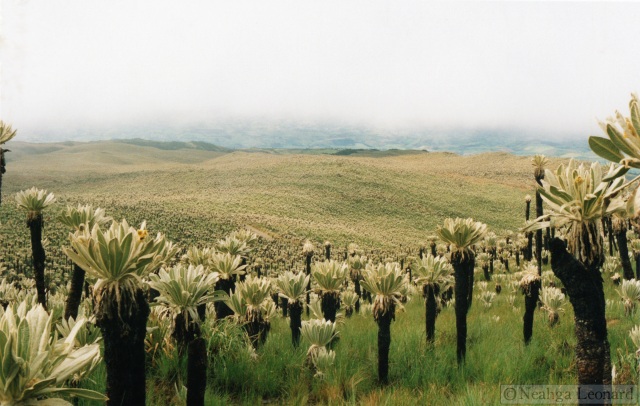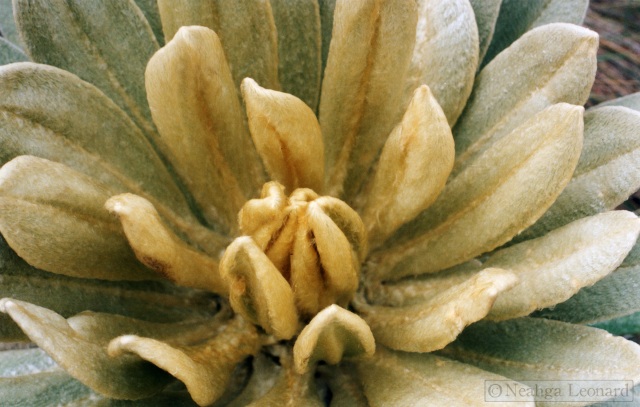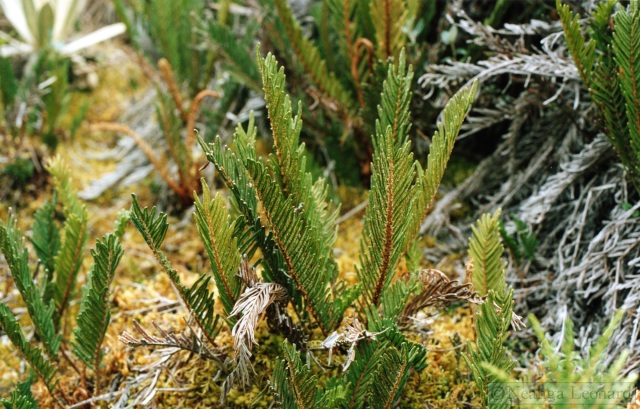A number of years ago I spent some time working in South America. I started in Ecuador and slowly made my way down to Bolivia, participating in a variety of interesting projects in remote areas, interspersed with travels between projects. When my project in Ecuador was completed I and my then girlfriend headed up to a northern town high in the Andes called El Angel where an unusual plant was said to grow in the páramo, the high elevation grassland of the Andes.
We had heard that the frailejón were rare and only grew in a few limited places in Ecuador, Columbia, and Venezuela. We didn’t know what to expect and I recall saying, “I hope we get to see one,” thinking that, like many rare plants, we would have to hunt for them.
We need not have worried. These large, palm tree-like asters are what would would be called globally rare, locally abundant.
Everywhere we looked the land was stippled with these strange plants, many of them in bloom.
We were above the cloud (or fog) forest, the bosque nebuloso, and well into the páramo, a place that is sometimes described as tropical alpine tundra. A land of grasses, cool weather, harsh sun and winds, clouds, and occasional freezing temperatures despite being in the middle of the tropics. As such, plants here have developed a variety of environmental coping mechanisms to deal with the particular stresses they endure.
The thick, fleshy leaves are covered in dense, pale fur that retains moisture, reflects sunlight, and insulates from the cold. The thick mat of fur creates a boundary layer of still air, acting much like the downy feathers of a bird or the thick fur of a beaver. The closely spaced leaves have a similar effect, the larger outer leaves protecting the younger and more sensitive inner leaves.
Frailejón are in the Asteraceae family (aka. Compositae), as such they are related to an enormous variety of flowers we are familiar with; sunflowers, daisies, dandelions, artichokes, marigolds, chrysanthemum, coneflowers, fleabane, and about 23,000 other species. All of these plants share a similar flower structure, and a look at the flowers of the frailejón clearly reveals this family association.
Like many grasslands the páramo is a fire prone region and plants must be able to cope with this stress as well. The grasses in the páramo tend to be bunch-grasses, perennial clumping grasses with long-lived root-masses. The nubby texture they give to the landscape must be very like what California looked like before the Columbian Exchange led to the replacement of perennial grasses with annual ones. In the Andes the bunch-grasses remain, perhaps in part because the local people still practice fire based land management. The tops of the bunch-grasses burn off, leaving the roots intact to resprout.
Frailejóns take a different approach to fire protection. They grow above it, raising themselves up on tall stalks, appearing like shrubby palm trees.
The largest I saw was close to 4 meters tall. The stalks are a straight cylinder, the same diameter no matter the height, and the leafy heads are also the same size no matter how tall the plant is. Old leaves dangle down, insulating the base of the active growing head from the fire below. The dead leaves felt a bit spongy, they may gather moisture from the fog as added protection.
The Andean spectacled bear (Tremarctos ornatus), which usually eats bamboo pith, has been known to tear down frailejóns to eat the interior of the stalk.
Frailejóns and bunch-grasses are not the only interesting plants in this region. Large agave relatives with narrow, sharply toothed leaves and tall flower spikes infrequently dot the landscape.
Tough cycad-like ferns grow in mossy areas where the grasses do not.
The landscape is… different. Not exactly alien, but unfamiliar. It is a little like walking through a dream or a Dr. Suess landscape.
* * * *** * * *
These photos were taken with a Canon AE-1 older than I am with a Canon 50mm f1.4 lens, developed and printed in Ecuador, mailed back to the US, eventually to be scanned on an Epson (I forget the make) all-in-one printer.





